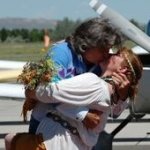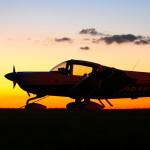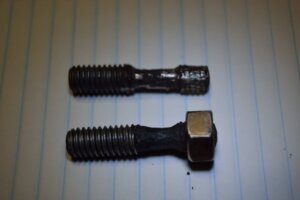Home › Forums › Maintenance of Grummans › Engine › Erroded Exhaust Studs
Tagged: Erroded Studs, RTV
- This topic has 3 replies, 3 voices, and was last updated 9 years ago by
 Roscoe Rosché.
Roscoe Rosché.
-
AuthorPosts
-
-
April 11, 2015 at 22:16 #1529
 Roscoe RoschéKeymaster
Roscoe RoschéKeymasterOne of the hard jobs to do by yourself is to put an exhaust system on a plane by yourself. It is tough to align the exhaust system with the studs and get all the exhaust no-blow gaskets on all at the same time. You can use cotter pins to hold the no-blows on the studs, then pull them off later.
Others use some high-temp RTV (the orange stuff) to act as a tack to hold the no-blow on the exhaust face while the exhaust goes up. First, RTV is an insulator so heat from the exhaust area does not transfer efficiently to the exhaust SS. Second, even if you get a perfect thickness layer of RTV, it will eventually burn through in a small area. This make a small jet for the hot, burning and corrosive exhaust gas to escape. Most of the time it leaks by the exhaust stud that holds the exhaust up. This will wear away at the shaft of the stud and maybe even weld the exhaust nut to the stud. This is not so bad as when you remove it, the nut and the stud come out as a welded unit.
Worst case is, the stud break and the cylinder has to come off and go to the shop. Expensive fix. Lastly, it will try and weld to the cylinder and take heat and lots of turning force (vice grips) to remove. I had one on a Tiger that took 3 hours, a bottle of MAP gas and a helper to remove.
Here are an example of each. The one without the nut is the one from the Tiger. This is why every exhaust system should be removed each year as called out in the Annual/100 Hour checklist.
-
April 13, 2015 at 19:06 #1540
 NathanParticipant
NathanParticipantSomething Roscoe pointed out to us on our annual is the metal gasket in the bead clamp holding the exhaust stack to the manifold (which you can see in the first picture). As he told us, over time with heat expansion and contraction, the gasket will begin to pinch and eventually allow some exhaust gasses to escape. When it gets to the point you see in the second picture, it might be time to retire them.
Another thing to periodically glance at on a pre-flight.Attachments:
You must be logged in to view attached files. -
July 1, 2015 at 12:03 #1799
 Tracy NorrisParticipant
Tracy NorrisParticipantAnd this is what happens when the stud either backs off or the previous owner decides to use RTV instead of a dedicated exhaust gasket. The erosion of the exhaust port on my #3 cylinder necessitated a replacement cylinder at annual. No telling how much carbon monoxide this was letting in the cabin.
Erosion can be seen on the right side of the right port.
-
July 1, 2015 at 19:27 #1802
 Roscoe RoschéKeymaster
Roscoe RoschéKeymasterTracy,
Nice picture for a bad part. Those 10 dollar no-blow gaskets cost a lot less than a cylinder.
That pink color is the indication of excessive heat, so everyone look for it on your cylinders and find out why you have it!
-
-
AuthorPosts
- You must be logged in to reply to this topic.
